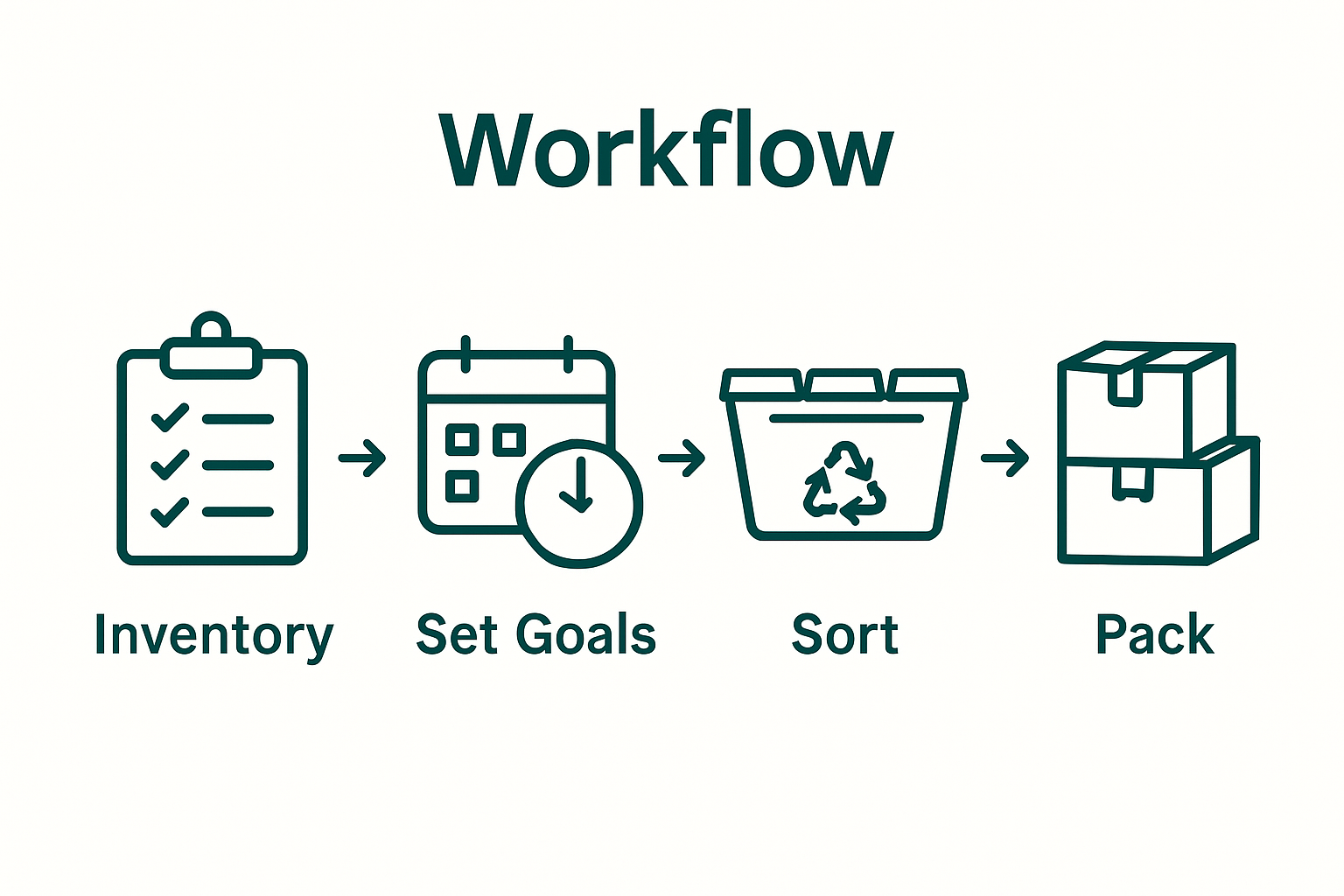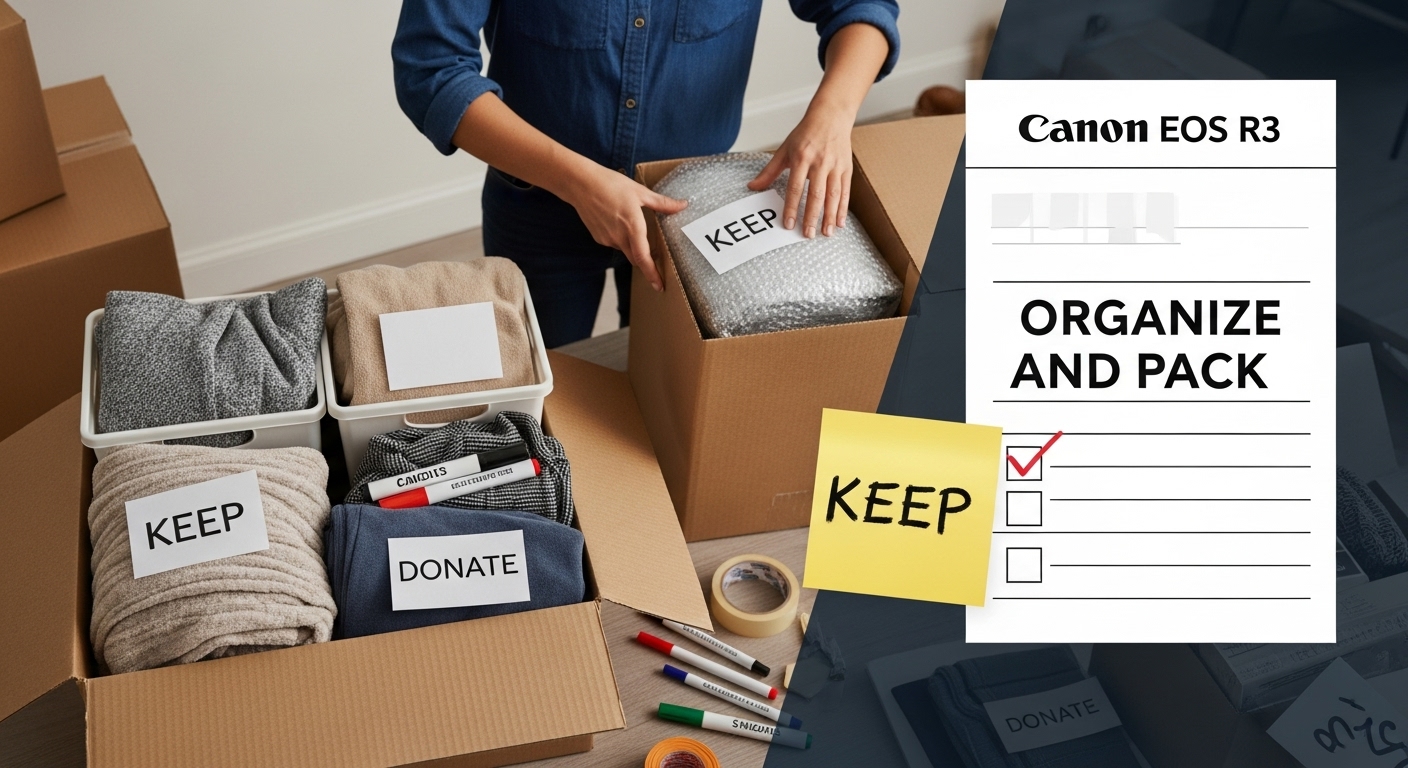You know that moment when you’re getting ready to move and you open a closet door, only to be greeted by an avalanche of stuff you forgot you even owned? Yeah, we’ve all been there.
It’s wild to think that the average American home is packed with over 300,000 individual items – and honestly, that number starts to feel very real when you’re standing in your living room surrounded by boxes, wondering how on earth you accumulated so much.
Most of us go into a move thinking it’s all about finding the right moving company and buying enough tape. But here’s what nobody tells you: the real game-changer isn’t the logistics – it’s that moment when you’re forced to pick up every single thing you own and ask yourself, “Do I actually need this?” It’s part archaeology dig, part therapy session, and part reality check all rolled into one.
Table of Contents
Quick Summary
| Key Point | Explanation |
| 1. Assess Your Inventory Thoroughly | Create a detailed list of belongings to understand what to keep, donate, or discard before moving. |
| 2. Set Decluttering Goals with Deadlines | Establish clear, achievable objectives and timelines for decluttering each area to maintain focus and motivation. |
| 3. Sort Items into Clear Categories | Organize belongings into ‘Keep,’ ‘Donate,’ ‘Sell,’ or ‘Discard’ piles to streamline decision-making and reduce moving volume. |
| 4. Pack Items Strategically | Use a systematic approach to pack, ensuring fragile items are protected and boxes are properly labeled for easy unpacking. |
| 5. Conduct a Final Verification Pass | Review each area critically to confirm completeness and intentionality, ensuring you’ve curated items that truly support your lifestyle. |
Step 1: Assess Your Current Inventory
Decluttering before a move requires a systematic and strategic approach that starts with a thorough inventory assessment. This critical first step helps you understand exactly what you own, what you need, and what can be removed before your transition. By creating a comprehensive overview of your belongings, you’ll set the foundation for a smoother, more efficient moving process.
Begin your inventory assessment by walking through each room of your home with a dedicated notebook or digital spreadsheet. Take your time and be methodical. Start in one corner and move systematically around the space, documenting items by category. Note furniture, electronics, clothing, kitchenware, decorative items, and personal collections. As you document each item, consider its practical value, emotional significance, and current condition.
According to the University of Minnesota Extension, creating a detailed household inventory should include specific information about each item. Beyond just listing objects, record their approximate purchase date, original cost, and current condition. This approach transforms your inventory from a simple list into a valuable resource that can help with insurance documentation and strategic decision making during your move.
As you compile your inventory, be honest about each item’s role in your life. Ask yourself critical questions: When was the last time I used this? Does this item serve a current purpose? Would I replace this if it were lost? These questions help you distinguish between items worth keeping and those ready for donation, sale, or disposal. Pay special attention to items stored in less frequently visited areas like attics, basements, garages, and storage closets.
These spaces often harbor forgotten items that can significantly impact your moving process.
To make your inventory assessment more manageable, consider categorizing items into clear groups:
-
Keep: Essential items you use regularly and want in your new space
-
Donate: Items in good condition that could benefit others
-
Sell: Valuable items you no longer need but could generate some moving funds
-
Discard: Damaged or obsolete items with no remaining practical value
By completing this detailed inventory assessment, you’ll have a clear roadmap for your decluttering journey.
 Your documented inventory becomes a powerful tool that guides subsequent decisions about what moves with you and what stays behind. Remember, the goal isn’t just to reduce volume, but to curate a collection of belongings that truly support your lifestyle and upcoming transition.
Your documented inventory becomes a powerful tool that guides subsequent decisions about what moves with you and what stays behind. Remember, the goal isn’t just to reduce volume, but to curate a collection of belongings that truly support your lifestyle and upcoming transition.
Step 2: Set Decluttering Goals and Deadlines
After completing your comprehensive inventory, the next critical phase of decluttering before a move involves establishing clear goals and realistic deadlines. This step transforms your initial assessment into an actionable plan, providing structure and motivation for your decluttering journey. Without specific objectives, the process can quickly become overwhelming and lose momentum.
According to Tufts University, treating decluttering as a scheduled commitment dramatically increases success rates. Begin by breaking down your entire home into manageable sections. Instead of viewing decluttering as one massive task, segment your project into smaller, more approachable zones. For instance, tackle one room or even one closet at a time. Assign specific timeframes to each section, ensuring you maintain steady progress without burning out.
Create a detailed timeline that aligns with your moving date. Work backward from your anticipated move date, allocating realistic time blocks for each area of your home. Some zones will require more time than others. A cluttered home office might need an entire weekend, while a minimalist bedroom could be sorted in a few hours. Be honest about your available time and energy. Factor in work commitments, family responsibilities, and personal limitations when designing your schedule.
Establish clear metrics for success in each decluttering session. Rather than vague goals like “clean out the garage,” set precise targets such as “sort through all stored boxes and reduce storage volume by 50%.” These concrete objectives provide motivation and a sense of accomplishment. Track your progress using a physical calendar or digital tracking app, marking completed sections and celebrating small victories along the way.
To maintain accountability and momentum, consider these strategic approaches:
-
Create visual progress trackers in prominent locations
-
Schedule dedicated decluttering time slots in your calendar
-
Reward yourself after completing each designated section
-
Share your goals with a friend or family member who can offer support
Remember that flexibility is key. While having a structured plan is important, unexpected challenges may arise. Be prepared to adjust your timeline if needed, but never abandon your overall decluttering objective. Each small step brings you closer to a streamlined, stress-free moving experience. By setting clear goals and deadlines, you transform an potentially chaotic process into a manageable, even enjoyable, journey of simplification.
Step 3: Sort Items into Keep, Donate, Sell, or Discard
With your inventory complete and goals established, the sorting phase represents the most transformative part of decluttering before a move. This critical step requires decisive action and emotional clarity as you evaluate each item’s true value and purpose in your life. Making intentional choices about your belongings will not only reduce moving volume but also create space for new opportunities and experiences.
According to Yale University’s decluttering guidance, the sorting process should be methodical and strategic. Begin by gathering essential supplies: several sturdy boxes or bins labeled for different categories, packing tape, marker, and trash bags. Choose a systematic approach by focusing on one room or area at a time. This prevents feeling overwhelmed and allows you to maintain momentum throughout the sorting process.
As you handle each item, make an immediate decision. Hesitation breeds clutter, so train yourself to be quick and decisive. Ask yourself pointed questions: Have I used this in the past year? Does this item align with my current lifestyle? Would I purchase this again today? If the answer is no, it likely belongs in the donate, sell, or discard category. For sentimental items, create a separate small box for meaningful keepsakes, but be ruthlessly selective about what truly deserves preservation.
Establish clear criteria for each sorting category to guide your decision-making:
-
Keep: Items essential for daily living, high-quality pieces with ongoing utility, and truly meaningful personal objects
-
Donate: Clean, functional items in good condition that could benefit others
-
Sell: Valuable items in excellent condition with potential market demand
-
Discard: Damaged, obsolete, or non-functional items with no remaining practical use
Consider the financial and emotional cost of moving every single item. Each object you choose to transport requires packing, loading, unloading, and potential storage. Lighter loads mean easier transitions. For items of significant monetary or sentimental value that you’re uncertain about, take a moment to research their potential resale value or consider photographing them as a memory preservation technique before letting them go.
Verify your sorting process by doing a final review of each category. Ensure donation and selling piles are clean, organized, and ready for their next destination. Trash and recycling should be immediately removed from your space. Your keep pile should feel intentional, representing only items that truly matter in your upcoming life transition. By completing this sorting step, you’ve transformed a potentially stressful task into an empowering journey of simplification and renewal.
Step 4: Organize and Pack Selected Items for Your Move
Organizing and packing your selected items transforms your decluttering efforts into a practical moving strategy. This crucial step requires careful planning, strategic approaches, and systematic execution to ensure your belongings arrive safely and efficiently at your new destination. Preparation is the key to a smooth packing experience.
According to the Federal Motor Carrier Safety Administration, proper organization begins with gathering the right packing materials. Invest in high-quality, sturdy boxes in various sizes, packing tape, bubble wrap, packing paper, and permanent markers. Collect additional padding materials like towels, blankets, and clothing to provide extra protection for fragile items. Create a dedicated packing station in a central area of your home where you can systematically work through your belongings.
Start packing with a room-by-room approach, beginning with areas least used in your daily life. Typically, this means storage spaces, guest rooms, and seasonal item collections. Pack similar items together and use clear, descriptive labels on each box. Include both the contents and the destination room on each box to streamline unpacking. For delicate or valuable items, consider using specialty boxes or custom padding. Wrap breakable items individually in bubble wrap or packing paper, placing them carefully with additional cushioning between layers.
Implement a strategic packing system to maximize efficiency and minimize stress:
-
Pack a personal “first night” box with essential items you’ll need immediately upon arrival
-
Keep important documents, medications, and valuables with you during the move
-
Create an inventory list that matches box numbers to their contents
-
Use color-coded stickers or labels to quickly identify box destinations
Be mindful of weight distribution when packing boxes. Heavier items should go in smaller boxes, while lighter items can fill larger containers. This approach prevents boxes from becoming too heavy and reduces the risk of breaking. For electronics and sensitive equipment, use original packaging if available, or invest in padded, static-free packing materials. Take photographs of complex setups like computer connections before disassembling to help with reassembly at your new location.
Here is a helpful table summarizing essential tools and materials you should gather before organizing and packing for your move, including their purpose for a more efficient process.
| Tool/Material | Purpose |
| Sturdy boxes (various sizes) | Protect and organize items for transport |
| Packing tape | Securely seal boxes and containers |
| Bubble wrap | Cushion fragile and breakable items |
| Packing paper | Wrap and protect items from scratches |
| Permanent markers | Clearly label boxes with contents and destination room |
| Towels/Blankets | Extra padding for delicate objects |
| Color-coded stickers | Quickly identify box destinations during unpacking |
Verify your packing process by conducting a final walkthrough of each room. Ensure no items are accidentally left behind, and all boxes are securely sealed and labeled. Your goal is to create a systematic, organized approach that reduces moving day stress and provides a clear roadmap for unpacking.
 By completing this meticulous packing step, you’re transforming your decluttering efforts into a well-executed moving strategy that sets the stage for a smooth transition to your new home.
By completing this meticulous packing step, you’re transforming your decluttering efforts into a well-executed moving strategy that sets the stage for a smooth transition to your new home.
Step 5: Verify Completeness of Decluttering Process
The final stage of decluttering before a move is a comprehensive verification process that ensures nothing falls through the cracks. This critical step transforms your hard work into a confident, streamlined moving strategy. Verification is more than a simple once-over it’s a methodical approach to confirming you’ve truly optimized your belongings for the upcoming transition.
According to AARP, avoiding the infamous ‘maybe’ pile is crucial during this verification stage. Begin by conducting a final room-by-room walkthrough, this time with a more critical eye. Bring a fresh notepad and approach each space as if you were seeing it for the first time. Look behind doors, inside drawers, and in hidden storage spaces that might have been overlooked during previous sorting attempts. Pay special attention to areas like closets, under-bed storage, garage shelves, and attic spaces where items tend to accumulate unnoticed.
Create a systematic verification process that goes beyond visual inspection. Take photographs of each room after sorting to provide a visual record of your progress. Compare these images against your original inventory list, ensuring every item has been accounted for and deliberately placed into its appropriate category. Challenge yourself with tough questions: Would I buy this item again today? Does this truly represent who I am now? Does this item support my future goals? If the answer is no, it’s time to reconsider its place in your moving plan.
Implement these verification strategies to ensure a thorough decluttering process:
-
Conduct a second pass through all ‘keep’ boxes
-
Weigh packed boxes to ensure manageable weight distribution
-
Check that donation and selling piles are clean and organized
-
Verify all important documents and valuables are secured
Consider enlisting an objective second opinion. Ask a trusted friend or family member to walk through your sorted items. Fresh eyes can often spot overlooked clutter or challenge decisions you might have made emotionally. This external perspective can provide valuable insight and additional confidence in your decluttering choices. Be open to constructive feedback, but also trust your initial instincts about what truly matters to you.
Use this checklist table to guide your verification process and ensure you’ve completed all critical tasks before your move.
| Verification Task | What to Check | Completion Status |
| Conduct second pass through ‘keep’ boxes | Ensure only essential items remain | |
| Weigh packed boxes | Confirm each box has manageable weight | |
| Check donation and selling piles | Items are clean, organized, and ready for next steps | |
| Verify important documents & valuables | All are accounted for and secured | |
| Photograph each room after sorting | Document progress and check against your inventory list | |
| Confirm no items left in hidden spaces | Inspect closets, drawers, garages, attic spaces |
The ultimate verification comes from feeling a sense of lightness and clarity. Your space should feel intentional, not empty. You’re not just reducing possessions you’re curating a collection of items that genuinely support your lifestyle and future aspirations. By completing this final verification step, you’ve transformed decluttering from a mundane task into a powerful process of personal curation, ensuring that every item you move represents purpose, meaning, and forward momentum.
Simplify Your Move with STOMO’s Expert Support
Decluttering before a move can feel overwhelming with tough decisions about what to keep, donate, or discard. You want a smooth, stress-free transition and control over your belongings, but managing sorting, packing, and logistics can quickly become exhausting. Understanding strategies like item assessment and methodical sorting helps, but moving is still a huge job for most families and businesses.
Discover how STOMO Mobile Storage and MOVEMO Moving Service makes mastering each decluttering step easier. Our weather-resistant portable storage containers are delivered right to your door anywhere in South Carolina. You pack on your schedule and your pace. We then move everything safely and efficiently—even hanging your pictures at your new home. With personalized moving solutions and flat-rate pricing, you avoid the hidden fees and pressure from big chain providers. Our award-winning, local team brings trust, responsiveness, and genuine care so you never have to go it alone.

Ready to turn a successful decluttering plan into a truly seamless move? Let your journey begin with STOMO Storage and Moving. Outpace the overwhelm—request your custom storage or moving solution today for a stress-free, simplified moving experience.
Frequently Asked Questions
What is the first step in decluttering before a move?
The first step is to assess your current inventory by creating a detailed list of all your belongings, noting their condition and significance to decided what to keep, donate, sell, or discard.
How can I set effective decluttering goals before moving?
To set effective goals, break your project into manageable sections, assign specific timelines to each, and establish clear metrics for success to keep yourself motivated throughout the decluttering process.
What criteria should I use to sort items into keep, donate, sell, or discard categories?
Use criteria such as practical value, frequency of use, personal significance, and overall condition to make decisive choices about where each item belongs during your sorting process.
How do I ensure that my packing process is organized after decluttering?
To ensure an organized packing process, gather high-quality packing materials, pack items room by room, label each box clearly with contents and destination, and create an inventory list that matches box numbers to their contents.
